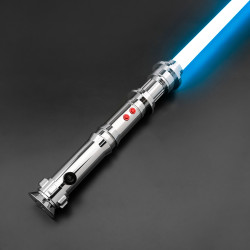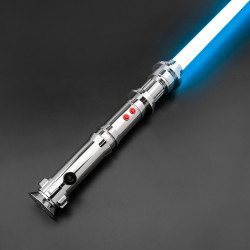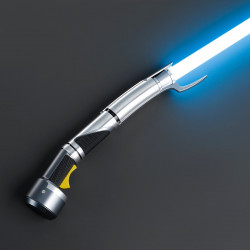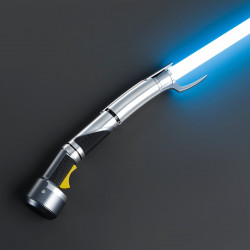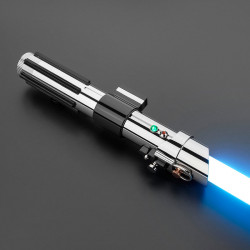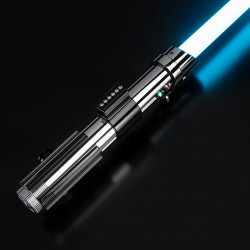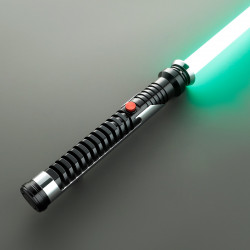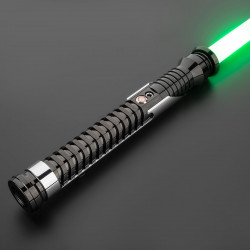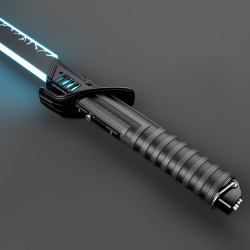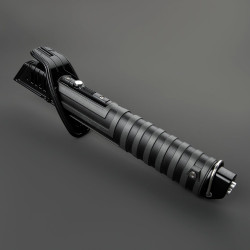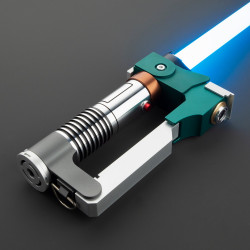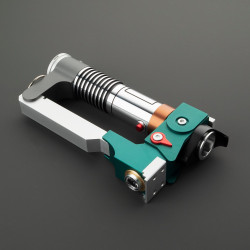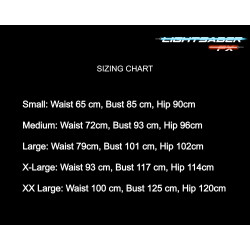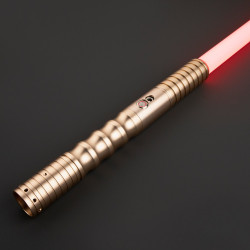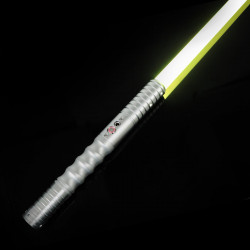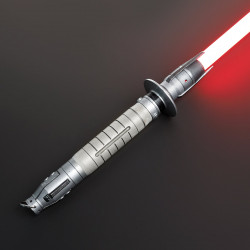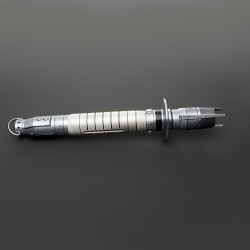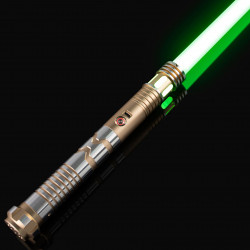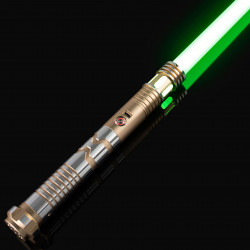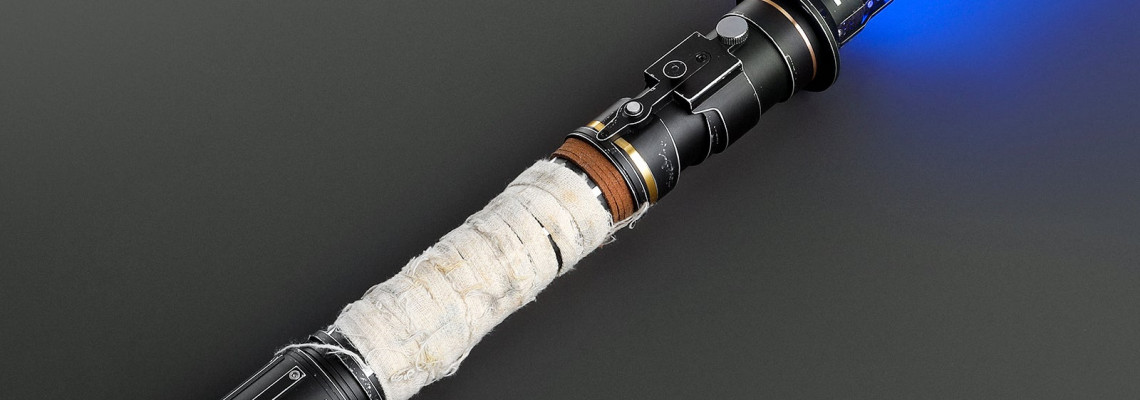
Every Single Lightsaber Crystal in Star Wars Explained
1. What are Lightsaber Crystals?
A lightsaber's energy source was a varied collection of crystals, gems, stones, and other items known as lightsaber crystals.
Each lightsaber had a single crystal at its center that resonated to produce a strong, effective blade. Although the most often utilized crystals were those from the Adega system, Ilum, and Dantooine's Crystal Cave, both Jedi and Sith used a range of crystals to produce various hues, effects, and special skills.
Certain crystals could even improve a user's Force talents. Furthermore, some gems, such as diamonds or colorful crystals, were utilized only for their prismatic properties. But not every lightsaber focus crystal was a genuine "crystal." Many Jedi and Sith replaced crystals with other materials or substances, like shards of glass, physical remains, or specialized micro technology.
In place of crystals, Kunda stones, a naturally occurring geological structure from the planet Kadril, were used to make several lightsabers during the Great Sith War. These stones have a number of valuable applications in communications and medicine, but they create a larger beam when paired with other concentrating crystals.
2. What is the Process For Crystal Imbuement and Lightsaber Construction?
The Jedi or Sith had to infuse the crystal with the Force before inserting it into the lightsaber. The Force-user had to meditate on the crystal for several days to complete this process. For example, Luke Skywalker, along with R2-D2, pondered his crystal in Ben Kenobi's house.
The Sith preferred artificial red-hued crystals, whereas the Jedi usually used natural ones. But since natural crystals were scarce on Tatooine, Luke Skywalker made his lightsaber out of a synthetic one. Energized by the dark side, Sith-made synthetic crystals yielded a marginally more potent blade. Sometimes, a Jedi's blade could even be "broken" by a Sith lightsaber. Darth Sidious gave Darth Maul instructions to create his crystals in a specialized furnace. For days, Maul worked tirelessly to create the four crystals that would make up his double-bladed lightsaber.
Maul needed to be extremely focused during the creation process because he had to utilize the Force to keep himself alive in the furnace's searing heat, mould the crystals, and purge impurities. Maul was incredibly proud of this achievement, seeing it as evidence of the Sith's dominance over the Jedi. Sidious, however, gave Tyranus and Vader, his later trainees, crystals himself rather than requiring them to make theirs in this manner.
Instead of utilizing a natural lightsaber crystal, Luke Skywalker chose to make his own using a unique furnace he found in Obi-Wan Kenobi's house. Forging a synthetic crystal required directing the Force energy and personality of the creator into the crystal, as both Skywalker and Maul showed. This created a unique crystal, including its color.
The Jedi Order discovered a sophisticated method for cleaning artificial crystals made by dark-side users, ridding them of the evil and hatred of their previous owners. After losing his second lightsaber in 41 ABY, Jaden Korr used this method to cleanse the red crystal of a Dark Jedi he had vanquished. The Dark Jedi's weapon changed into a yellow lightsaber when he was able to expel the dark side from the crystal and infuse it with the light side through meditation.
3. What Do Lightsaber Crystal Colors Represent?
Jedi utilized lightsaber focus crystals to represent their class around 4000 BBY. A Jedi Guardian, who used physical contact to interact with the Force, was symbolized by a blue crystal. A Jedi Consular, who concentrated on unravelling the mysteries of the Force and battling the dark side's core, was represented by a green crystal. A Jedi Sentinel, who combined fighting skills with academic knowledge, was represented by a yellow crystal.
As time went on, most Jedi stopped doing this, finally selecting green or blue gems from Ilum caves according to personal taste. It became uncommon to employ crystals from other source worlds. Yellow crystals were still used for lightsabers in specific roles, including as the Temple Guards. Even though Jedi continued to use purple and orange crystals on occasion until the dissolution of the Jedi Order, they were very uncommon and frequently passed down through the generations.
The Galactic Empire forbade the ownership and exchange of lightsaber focus crystals during the Galactic Civil War. Because the Jedi of the New Jedi Order could not obtain Ilum crystals, they had to use a variety of crystals and gems, which led to lightsaber blades with a wide range of hues.
See our article Lightsaber Color Meanings for additional information on the meanings of lightsaber hues.
4. Lightsaber Crystals
It is possible to create a lightsaber using a variety of stones, minerals, and crystals, each of which adds its colors and effects. Generally speaking, the more influential the crystal's impact on the lightsaber, the rarer it is.
4.1 Adegan Crystals
The rare, Force-reactive stones known as Adegan crystals, a kind of lightsaber crystal commonly utilized by Jedi, were primarily found in the Adega system, though they were also found on the planet Halm. Mygeeto and portions of the Cularin asteroid belt were among the other known sites.
Jedi were able to create a connection between themselves, the Force, and their weapon because Adegan crystals had a special connection to the Force. As a result of this connection, lightsabers that contained Adegan crystals sent off a subtle Force signature that other Jedi could detect.
Ilum crystals had structural similarities with the mephitic and petite varieties of Adegan crystals, which are renowned for creating the sharpest lightsaber blades. Even though they were identical, Ilum crystals were far more frequent among Jedi until the Great Jedi Purge because they were found in entire caves of superior crystals. On Ilum, the majority of Padawans participated in the custom of making their first lightsaber.
Ilum crystals were mainly blue or green, with a few purple ones here and there. Despite having a weaker Force connection than Adegan crystals, they had the qualities required for a Jedi's weapon. These crystals produced intense light bursts when stimulated by resonant frequencies, which other lightsaber parts then collected into a rod-like beam. Obi-Wan Kenobi's first lightsaber was made using an Adegan crystal.
The Sith Empire used adegan crystals mined from Ilum to build a stealth armada during the Cold War.
The Galactic Empire outlawed the ownership of any crystal that could be used to make a lightsaber when Order 66 was put into effect.
Types of Adegan Crystals:
- The most prevalent type of Adegan crystal was anthracite, which was followed by danite and related. Usually employed in sabre training, these crystals were less efficient at concentrating energy than their rarer cousins.
- Jedi frequently used mephite, a popular Adegan crystal.
- The rarest and strongest kind of Adegan crystal was pontite. It was tough to locate and radiated a strong aura that chilled its wielder's skin and temper.
4.1.1 Kathracite Crystals
One kind of crystal that may be utilized to make lightsabers is anthracite. The Jedi Order frequently employed anthracite crystals in addition to danite crystals when teaching lightsabers to Jedi Initiates. Because of these crystals, the lightsabers produced very little power and were not fatal.
4.1.2 Danite Crystals
In order to train their younglings' lightsabers, the Jedi Order employed danite crystals somewhat frequently. These were non-lethal, low-powered lightsabers.
4.1.3 Mephite Crystals
The uncommon and shiny kyber crystals known as mephite crystals, or just mephite, were found on Ilum and in a few other places in the Adega system.
One of the five crystal kinds known as adegan crystals, graphite crystals were valued for their internal structure and light-modulating qualities, which made them perfect for use in lightsabers. Mephite crystals, like other adegan crystals, were Force-reactive and could be made to absorb a tiny bit of a Force-sensitive power. When mephite crystals were placed in a lightsaber and filled with the Force, they released a faint but consistent Force signature that other Force users could detect.
Thousands of years before the Galactic Empire was formed, Jedi survey teams found graphite and petite crystals on Ilum.
4.1.4 Pontite Crystals
The kyber crystals, known as pontite crystals, or just pontite, were found in the caverns of Ossus and on the frigid planet Ilum. They were frequently utilized to make Jedi lightsabers.
Along with graphite crystals, Jedi survey teams found petite crystals on Ilum thousands of years before the Galactic Empire rose to power. Among the unique crystals discovered in the caverns of Ossus was pontite. The rare petite crystal used to build the Greenwood Saber.
Helical HyperCom also used petite crystals in its communication device manufacturing to cut production costs in half and double bandwidth until Galen Walton Erso, a company employee, proposed substituting them with synthetic resin.
4.1.5 Relacite
One kind of manufactured crystal was relacite. A firm employee named Galen Walton Erso suggested that Helical HyperCom switch from using petite crystals in their communication devices to synthesized relate in order to save money and increase bandwidth.
4.2 Amplification Crystals
Much is still unknown about the origins of amplification crystals. Two of these silver crystals were used in Darth Vader's experiment Maulkiller, which was developed utilizing the genetic information of Darth Maul and Galen Marek. In the end, Maulkiller died of severe mental and physical instability, leaving his crystals in limbo.
4.3 Ankarres Sapphire (Antares Crystal)
In addition to its many other benefits, the Ankarres Sapphire, also called the Antares crystal, was well-known for its fabled healing powers. It was extremely potent and one of the most powerful crystals that could be used to make lightsabers, greatly assisting a Jedi in combat.
Legend had it that only light-side users could wield the Ankarres Sapphire. The crystal or sabre would slowly heat up and burn the hand of anyone who touched it if they were on the dark side. It is said that if the crystal ended up in the wrong hands, this impact might be undone.
It's possible that Meetra Surik found the gem circa 3951 BBY. Later, Dom Pricina kept it on board the Kuari Princess until the droid 4-LOM took it just prior to the Battle of Yavin. 4-LOM recovered the sapphire and returned it to his partner, Zuckuss, after attempting to pawn it on Darlyn Boda without success. Then Zuckuss tried to heal the Gand and Samoc Farr with the Ankarres Sapphire. After that, the bounty hunter kept the sapphire.
4.4 Illya's Redemption
Allya's Redemption was a powerful crystal that was occasionally utilized to make lightsabers. It gave the sword a strong corrosive impact when employed in battle, severely poisoning adversaries. Allya, a rebellious Jedi, inspired the crystal's name.
With a yellow core and an elusive light green hue, Allya's Redemption gave the lightsaber blade a distinctive look that reflected the crystal's venomous nature.
4.5 Illya's Exile
Allya's Exile was a potent crystal that was occasionally used to make lightsabers. It was well-known for producing a terrible burn effect when fighting.
This crystal, named for the rebellious Jedi Allya, gave the lightsaber blade a vivid scarlet hue that reflected its intense heat. Allya's Exile was significantly more powerful than the Sigil crystal, although it had a comparable purpose.
4.6 Bnar's Sacrifice
The famous Jedi Master Ood Bnar previously possessed a unique brown lightsaber crystal known as Bnar's Sacrifice. Bnar left this crystal as a legacy for future generations following his downfall during the Old Republic era. The crystal became exclusively tied to the Force-sensitive person who attuned it to their lightsaber, making it impossible for anyone else to utilize.
4.7 Bane's Heart
Following the Seventh Battle of Ruusan, Darth Bane, Darth Zannah's Sith Master, gave her a rare carmine lightsaber crystal known as Bane's Heart. She named the weapon after the crystal and put it into her double-bladed lightsaber.
Somewhere on Dica or Necropolis, the lightsaber and its crystal finally ended up in the hands of a Dark Jedi, who General Grievous, the Supreme Commander of the Droid Armies in the Confederacy of Independent Systems, then killed. The weapon was later recovered by Imperial forces and utilized in the N-K Project, but Grievous retained it on board his own starfighter. N-K Necrosis used the Bane's Heart lightsaber during the Galactic Civil War until he was assassinated by a group of spacers, who subsequently stole the crystal from his body.
When attuned to a lightsaber, Bane's Heart causes the weapon to discharge electricity, making it difficult for anyone other than its legitimate owner to wield.
4.8 Barab Ingots
Rare lightsaber crystals known as "Barab Ingots," or "Barab ore ingots," were discovered on the planet Barab I's radiation-scorched surface. Some were able to find ingots that could be used as focusing crystals in spite of the difficult circumstances. These ingots formed a precise, powerful blade that blazed nearly to the point of disintegration when incorporated into a lightsaber.
Constantly being around Barab, The sword had a flaming quality due to I's radiation, which frequently caused everything it impacted to fire. Examples of Barab ingot blades may be found in almost every prevalent lightsaber color.
4.9 Blackwing Crystals
The Blackwing virus, a Sith bioweapon that transforms its victims into zombie cannibals, causes strange lightsaber crystals known as Blackwing Crystals. These crystals created a dark, smokey ash blade that was employed in a lightsaber. During a Blackwing virus breakout on Dathomir during the Galactic Civil War, they were found in the Quarantine Zone's caves. In 1 ABY, a party of spacers discovered a collection of these crystals and killed a massive zombie rancour in a cave beneath the Imperial Research and Prison Facility, where the virus had escaped control.
4.10 Bondar Crystals
A lightsaber blade's energy was changed into a different form by bondar crystals, which made the blade stun instead of cut. Because of this, Bondar crystals were frequently utilized in the Old Republic era for sabre training.
An asteroid in a far-off orbit orbiting the Alderaan system was the only known source of Bondar crystals. If an opponent's flesh came into contact with the blade of a lightsaber, these crystals could momentarily stun them.
4.11 Bondara's Folly
A special lightsaber crystal known as Bondara's Folly was named for the Twi'lek Jedi Master Anoon Bondara. When placed in a lightsaber, this gem created a light-brown blade. It became a focusing crystal that could only be used in that person's lightsaber after being adjusted by a Force-sensitive person. Bondara's Folly was created by a spacer who gathered and fused different crystal bits from all over the galaxy after the Battle of Yavin, which took place during the Galactic Civil War.
The brown lightsaber crystal known as Bondara's Folly gave a lightsaber blade a light-brown tint. When correctly tuned by a Force-sensitive, it transformed into a focusing crystal that could only be used in the lightsabers that the person tuning it built.
4.12 Baas' Wisdom
Baas' Wisdom was a rare gem that was rarely used to make lightsabers. When used in combat, it caused a freezing effect that left its recipient with mild frostbite. Additionally, the crystal provided a lightsaber blade with its characteristic navy blue hue.
4.13 Compressed Energy Crystal
One kind of lightsaber crystal was a compressed energy crystal, sometimes referred to as a compressed crystal or CEC.
CECs were essential to Ves Volette's light sculptures because the gaseous light inside would collapse if the crystals were removed. Certain compressed crystals were employed in lightsabers to give the energy blade a distinctive "pulsating" look with a thinner core, giving the impression that the blade was more accurate than other lightsaber blades.
Luxum and Corusca jewels are examples of crystals with compressed energy.
4.13.1 Luxum Crystal
One kind of crystal used to make lightsabers was called a Luxum crystal. These crystals, which came from the darkly charged planet Ambria, were created by lengthy periods of intense meditation using the minerals and Force energy of Lake Natth.
Luxum crystals, when integrated into a lightsaber blade's design, produced an ion effect and were very powerful against droids. After losing his old lightsaber in combat with Darth Vader, the renegade Jedi Jax Pavan set out to make a new one, and these crystals were among the minerals he sought.
4.13.2 Corusca Gems
Corusca gems, sometimes referred to as Corusca stones or jewels, were highly costly and uncommon crystals. They were created in the atmospheres of some gas giants, such as Yavin Prime, by scraping the planet's liquefied air against its metallic core and applying highly high pressures, which are enough to fuse elements. These diamonds grew in size as they approached Yavin's center. Because Corusca jewels were only found in a few distinct places around the galaxy, the galactic capital was named Coruscant in honour of their vivid brilliance. These jewels also inspired the name of the Corusca Gem Casino.
The main reason Corusca stones were valued was their exquisite beauty. The appearance of a flaming furnace was produced by light reflecting inside a Corusca gem. Because of their captivating qualities, the gems became highly sought after, and Corusca gem fishermen like Bash Fateau rose to prominence, earning a living by collecting these valuable stones.
Among the galaxy's most challenging materials, corusca jewels were prized for their ornamental and industrial uses. When explosives were not viable, large Corusca jewels were frequently put on drills for precise drilling.
Corusca gems were known for their toughness, but they also featured tiny, weak areas called shatter points where several edges and facets met. The entire gem could shatter with a well-timed and accurate tap at one of these shatter points.
Using a bag of Corusca jewels, Supreme Chancellor Palpatine once attempted to lure Anakin Skywalker into believing he could have everything he wanted if he just asked. But Skywalker didn't care because his only concern at the moment was keeping his wife, Padmé Amidala, alive, as he had predicted in a Force vision.
Famously, Jacen Solo powered his lightsaber with a Corusca gem that was worth the equivalent of a whole Coruscant city block. He obtained the gem in Lando Calrissian's mining operation, GemDiver Station. Jacen Solo destroyed the Corusca gem that another Jedi, Ganner Rhysode, had put in his lightsaber while pretending to be loyal to the Yuuzhan Vong.
4.14 Corrosion Crystal
Starkiller, Galen Marek's clone, used the Corrosion crystal as a lightsaber. This red crystal was categorized as a compressed energy crystal. An opponent would rust when a lightsaber with a corrosion crystal came into touch with them.
4.15 Cunning of Tyranus
In honor of Count Dooku, the Human Separatist leader known as Darth Tyranus, there was a unique red lightsaber crystal called the Cunning of Tyranus. It made the blade of a lightsaber red when added. After being turned by a Force-sensitive person, it developed into a focusing crystal that the person who tuned it could only use in a lightsaber they made themselves.
4.16 Dahgee Crystal
During the Galactic Republic, the Dahgee Jedi used a lightsaber crystal known as the Dahgee crystal. These crystals created blades with unique characteristics, such as a colorful aura, a dark silver center, and a zigzagging pattern. They were frequently found in the lightsabers of Dahgee Jedi.
4.17 Damind
The Sith employed a particular kind of lightsaber crystal called Damind to make their lightsabers. It was known as damindium in its mineral form and was only found on the planet Daminia. When inserted into the crystal chamber, Damind created a blade that was longer and wider than a typical lightsaber, improving the lightsaber's capacity to fend off blaster fire.
4.18 Dantari Crystals
On Dantooine, a particular kind of lightsaber crystal called a "Dantari crystal" was found inside the eggs of the indigenous Kinrath animals. As seen by the Meetra Surik Crystal, these crystals were thought to represent the alignment of their wielder. The Jedi had a strong preference for Dantari crystals prior to the discovery of superior crystals on Ilum.
4.19 Dawn of Dagobah
Rarely employed in lightsaber construction, the Dawn of Dagobah crystal imparted an acidic effect that mildly poisoned combatants.
The Dawn of Dagobah crystal gave the lightsaber blade a distinctive teal color when it was in use.
4.20 Dragite Gems
Dragite gems were tiny, brittle, and dull kyber crystals that were found in the Expansion Region's D'olop mountain range on the artworld M'haeli. They were among the most fragile kyber crystals available and were challenging to form into a lightsaber. But when they were successfully integrated, they produced a loud hum and a shockwave when they hit a solid object. The target may be injured or confused by these shockwaves. The worth of granite gems was 14,000 credits.
4.21 Durindfire Gem
On the planet Tatooine, a valuable crystal known as the Durindfire gem was found. Although some were purchased and sold by the Galactic Empire to raise money for the Death Star project, very few Durindfire gems ever departed their home planet. By tracking the movement of these gems, the Alliance to Restore the Republic was able to identify the beginnings of the TIE Phantom Project and hunt down the Empire's production locations.
Traditionally utilized by the Jedi of the Halcyon/Horn line, a Durindfire gem gave any lightsaber blade a unique silver lustre.
Jawas made lenses with Durindfires to shield their rodent-like, delicate eyes from the intense sunshine. Nevertheless, the majority of Tatooine's other residents were ignorant of the jewels' actual significance and disregarded them as useless stones discovered in the desert sands.
4.22 Enhancement Jewel
A spherical part intended to be used in conjunction with a focusing lens in a high-resolution projection system was called an enhancement gem. One of these jewels was recovered from equipment left by Rebel technicians in the Great Temple on Yavin 4 and used as the crystal in the lightsaber of the Wookiee Jedi pupil Lowbacca in 23 ABY.
4.23 Eralam
Mined initially on the planet Erai's third moon, Eralam was a lightsaber crystal. However, ancient Sith forces' orbital bombardments made them extremely rare. When discovered, Eralam crystals emitted a superior and clean lightsaber beam, which was known as palladium in its crystalline form.
4.24 Etaan Crystals
Etaan crystals were unique lightsaber crystals that could only be discovered on the planet Etai in the Mid Rim. These peculiar crystals are tough to find because they developed deep below the planet's crust, usually no more than 500 meters below the surface and frequently more than 1,000 meters. It was almost impossible to locate them after Etai was destroyed.
Finding Etaan crystals was made easier by their unusual capacity to reverberate sound with a humming resonance. Even after the crystals were collected, this resonant quality remained. An Etaan crystal would create a blade that would hum in time with the movement of a lightsaber hilt. When it struck another lightsaber in battle, the crystal absorbed the energy from the blow, causing the blade to flare with energy and create a nearly loud crack.
The remarkable ability of an Etaan crystal-powered lightsaber to attract and absorb blaster bolt energy resulted in a brighter and more powerful blade with each absorbed shot. As the weapon continued to collect energy, this resonance effect made it more and more destructive.
4.25 Firkrann Crystals
The planet Rafa V was the source of the comparatively heavy lightsaber crystals known as Firkrann crystals. These crystals, when inserted in a lightsaber, gave the blade an electrical charge that made it very deadly against droids. The Dark Lords of the Sith were particularly fond of Firkrann crystals.
4.26 Focus Crystals
Focus crystals, when placed in a Jedi's lightsaber, improved the Jedi's Force connection, mainly while Force energy was being used.
While on Dagobah in 1 BBY, Galen Marek's clone found a focus crystal. Different crystals achieved different blade effects. For example, it was known that Kasha crystals from Ki-Adi-Mundi's homeworld of Cerea might help with meditation and Force attunement.
4.27 Ghost fire Crystals
Rare lightsaber crystals known as "ghost fire crystals" were found on a few worlds in the Outer Rim. Only one particular rock formation on a small number of planets was the source of these crystals. These ghost fire formations, which were frequently seen atop mountain summits, were made up of delicate spires of transparent stones. These crystals created a virtually translucent blade that flashed dimly when incorporated into a lightsaber hilt, creating an illusory afterimage of the saber and its wielder.
These blades were unique not only because they were colorless but also because they were nearly silent, without the characteristic hum that other lightsabers have.
4.28 Heart of the Guardian
Sometime prior to the Jedi Civil War, the Rodian inventor Suvam Tan unearthed an ancient crystal known as the Heart of the Guardian on the planet of Yavin 4. The redeemed Revan may have used it as a lightsaber crystal, giving whatever lightsaber it was placed in a distinctive bronze color with a yellow center. Revan may have obtained the Heart of the Guardian and the Mantle of the Force, two fabled crystals, from Tan toward the conclusion of his search for and destruction of the Star Forge.
This crystal improved the qualities of other crystals in a lightsaber, resulting in a quick yet strong blade perfect for lightsaber combat.
The Jedi Order is said to have been founded in part because of the Heart of the Guardian. Jedi prophecies stated that it would emerge to aid in the galaxy's Salvation during a period of extreme conflict. The Sith, on the other hand, saw it as a relic of their ancestry and thought it would help them conquer known space.
4.29 Hurrikaine Crystals
Deep blue to purple lightsaber crystals known for their extraordinary beauty were called Hurrikaine crystals, and they were found on the planet Hurikane. These gems created lightsaber blades that were very good at piercing defenses.
A teenage Padawan named Mace Windu was dispatched to Hurikane in 58 BBY. Windu received numerous rare amethyst Hurrikaine crystals as a reward for helping the stone-encrusted native species, and he utilized them to make his unique electrum lightsaber. Later, a crystal called Windu's Guile was made in the Jedi Master's honour.
4.30 Impact Crystals
A clone of Galen Marek owned a set of yellow lightsaber crystals known as the impact crystals. Because of these crystals, the clone was able to use his lightsabers to do more damage. They were categorized as compressed energy crystals and had a faint pulsing sound.
4.31 Incineration Crystal
Starkiller, Galen Marek's clone, used the incineration crystal, which was a lightsaber crystal. This orange-colored compressed energy crystal would ignite an opponent in flames when a lightsaber carrying it struck them, dealing them severe harm.
4.32 Kaiburr Crystal
On Circarpous V, also called Mimban, the ancient Force relic known as the Kaiburr crystal was initially found. The crystal multiplied a Force-sensitive person's ability by a thousand when placed in its native environment in the Temple of Pomojema on Mimban. This amplification improved skills like healing, fortifying one's bond with the Force, allowing people who would not usually be able to project Force lightning to do so, and reviving individuals in close proximity. The Kaiburr crystal could be utilized as a lightsaber crystal if it were cut correctly.
Initially, priests at the Temple of Pomojema employed the Kaiburr crystal to cure patients. The gem, however, sank into legend among the local Mimbanites after the temple was abandoned for unspecified reasons.
Before an older woman named Halla bought a shard of the crystal and a map pointing to Pomojema's temple from one of the Mimbanites circa 2 ABY, the crystal was only a myth. Leia Organa and Luke Skywalker, who had been on Mimban after a crash-landing, were then recruited by Halla to help them escape from prison. But when they set out to recover the ancient item, they unintentionally caught the eye of Darth Vader, the Dark Lord of the Sith.
Vader had arrived before them, but they eventually made it to the temple and found the crystal. Vader faced both Skywalker and Organa, and they engaged in combat. Despite the might of the crystal, he lost the battle after defeating Organa and knocking Skywalker to the ground. Luke Skywalker's lightsaber also took away his right arm.
Halla gave Skywalker the Kaiburr crystal, and he used its fabled focusing powers along with his natural Force sensitivity to heal both himself and Organa, who had suffered severe injuries in their combat. But as soon as the crystal departed the temple's vicinity, it lost its power and became totally helpless off-planet, something the gang was unaware of.
Vader kept the shard that had started the journey on Mimban until he gave it to the Dark Lady Lumiya, his apprentice. Later, when Luke Skywalker created his Jedi Praxeum and used it as a lightsaber-focusing crystal, he repurposed the crystal off-planet as a teaching tool.
4.33 Kasha Crystal
The Cereans traditionally utilized a crystal called a kasha as a meditation aid. It was used to remove distractions from the mind and create the perfect setting for in-depth meditation. The crystal, which may have been made by Bi-Dar Tyunda thousands of years ago, had patterns etched on each face to maximize its energy potential.
When combined with a lightsaber, the kasha crystal allowed the wielder to remain mentally sharp during fierce battle.
4.34 Katak Crystals
Katak The origins of crystals mainly were unknown, and they were surrounded by mystery. Usually, dark-side Force users' lightsabers contained these gems. This crystal's wielders could drain some of the life energy from everyone around them. Long-term exposure could be lethal, even though this effect wasn't instantly incapacitating.
4.35 Kenobi's Legacy
A crystal called Kenobi's Legacy was made to be used in a lightsaber. It needed to be fine-tuned before it could be installed, and once it was part of the sabre, nobody else could use it.
4.36 Krayt Dragon Pearls
The last chamber of a krayt dragon's gizzard contained shiny, vibrant stones known as krayt dragon pearls. These stones eventually got rounded from continuous movement and helped crush the creature's meal. Some of the colors of pearls were blue, green, red, white, and black.
If properly cleaned, prepared, and installed—a difficult task—they may be utilized in a lightsaber because of their unique refractive qualities. As evidence of having killed a krayt dragon, a mark of valour among Tusken Raiders, these pearls were extremely valuable and frequently valued at over 100,000 credits each.
Both Common and Greater Krayt dragons generated Pearls, but the Greater Krayt's pearls were more extensive and, therefore, more expensive.
4.37 Kun's Blood
During the Galactic Civil War, a lightsaber crystal known as Kun's Blood was found in the galaxy. In Hotfix 21.4, Kun's Blood was added to the raid system in the video game Star Wars Galaxies. The game makes no connection between the crystal and Exar Kun, a Sith Lord from the Old Sith Wars era, despite the fact that the two have the same name.
When it was time to harvest the lambent, it was cut from a milky sac hidden below the plant's leaves. The harvester or their assistant, usually a non-Yuuzhan Vong slave, had to gently touch the plant to quiet it before harvesting. Lambents were employed as light sources or communication crystals that could be made brighter or duller by the owner's thoughts. They could also be used to detect or sense hidden opponents.
4.38 Lambents
One kind of crystal that the Yuuzhan Vong gathered was lambent. In reality, these crystals were the product of a particular Yuuzhan Vong plant that flourished on a planet's surface or inside a gravity field produced by dovin basals. If lambent plants were planted in artificial gravity wells, like the interdiction fields on space stations or starships, they would not produce fruit.
4.39 Lava Crystal
Lava crystals were lightsaber crystals that could only be discovered on volcanic moons and planets like Must afar. The blade they created looked like molten lava. The lava crystal produced a dense, hefty blade that radiated intense heat because it was less concentrated and focused than other types of crystals. Due to the heat, lava and flame fragments periodically splattered and dripped from the blade. It was said that the lava crystal had extraordinary power.
4.40 Life Drain
Galen Marek's clone used a lightsaber crystal called Life Drain. The user of this green-hued crystal was able to drain other people's life power.
4.41 Lignan Crystals
Made from Lignan ore, a substance rich in the dark side of the Force, Lignan crystals were incredibly potent lightsaber crystals. These crystals made faster cutting through objects possible, which made lightsaber blades burn hotter and last much longer than those manufactured with regular crystals.
Lignan crystals also improved dark side users' Force talents. In one case, Jedi Grand Master Luke Skywalker and his son Ben were forced into battle before they could escape after a Sith strike team equipped with Lignan-enhanced lightsabers was able to cut through strong metal doors faster than they could.
4.42 Lorrdian Gemstones
Lightsabers were enhanced with crystals known as Lorrdian gemstones. Through careful monitoring of minor body language clues, the enslaved Lorrdians created kinetic communication to engage with one another during the Kanz Disorders, which enabled them to predict the movements of others, including their Argazdan oppressors.
Certain gemstones were endowed with these prophetic powers by some Force-sensitive Lorrdians. Installing these gems in a lightsaber improved the user's ability to deflect blaster bolts and improve their overall defence by allowing them to better read their opponent's moves.
4.43 Mantle of the Force
Suvam Tan rediscovered the powerful crystal known as the Mantle of the Force, which Revan later obtained. It added a cyan tint to the lightsabers. Near the end of his search for the Star Forge, Revan bought this crystal from Suvam Tan, along with another fabled crystal called the Heart of the Guardian. Installed within a lightsaber, the Mantle of the Force continuously improved Force skills while adapting its qualities to the capabilities of the other crystals.
4.44 Meditation Crystals
More profound meditation was made possible by naturally occurring stones called meditation crystals. Small pieces of these crystals, which were found in Tython's Deep Core world, may be incorporated into a lightsaber hilt to produce a coherent energy beam and support the wielder in keeping a closer bond with the Force while fighting. Instead of using up energy while battling, the user was able to conserve it thanks to this improved connection.
On their way to the SalvationSalvationSalvationSalvationSalvationSalvationSalvation, a clone of the former Sith student Galen Marek received two of these crystals from Jedi Master Rahm Kota.
4.45 Meetra Surik Crystal
The Meetra Surik gemstone was a naturally occurring gemstone that resonated with Jedi Meetra Surik and her Force connection, forming a unique link with her. Because of this connection, the crystal was able to adopt Surik's traits and develop her skills.
The crystal was found in a Force-sensitive cave on the Outer Rim world of Dantooine by Surik, who was banished from the Jedi Order for her involvement in the Mandalorian Wars while she was looking for Jedi Master Vrook Lamar following the Jedi Civil War. The crystal enhanced the effectiveness of the other parts and crystals in the lightsaber and made sure that only Surik could wield the weapon when it was employed as a focus.
4.46 Nextor
Nextor was a kind of crystal that was extracted from the mountains of the world M'haeli and occasionally used to make lightsabers.
Nextor created a very volatile but potent blade when it was inserted into the crystal chamber of a lightsaber.
4.47 Opila
4.47 Opila
Opila was a type of crystal sometimes used in lightsaber construction. It was mined from an asteroid field in the Fyrth system.
When placed in a lightsaber's crystal chamber, it produced an intense blade that could swiftly cut through most materials.
4.47.1 Jenruax
Before being used, Jenruax, a lightsaber crystal that was refined from Opila, needed to be cleansed of contaminants.
Jenruax improved a lightsaber's agility and deflected blaster fire more successfully when it was inserted in the crystal chamber of the blade.
4.48 Permafrost Crystals
Rare lightsaber crystals called permafrost crystals, which are found on the planet Hoth, are believed to give lightsaber blades an ice-blue tint. One of these crystals was in the possession of the settlement of Aurilia on Dathomir during the Galactic Civil War, and it was given to a spacer who played a crucial role in the Battle of Hoth.
The deep, icy blue coloring of permafrost crystals was translated to any lightsaber into which they were included. A permafrost crystal that was tuned for a lightsaber by a Force-sensitive person turned into a focusing crystal that could only be used in lightsabers that the person tuning it built.
4.49 Phond
Phond was a peculiar byproduct that was created when uncommon impurities linked together under enigmatic external circumstances during the production of specific alloys. This gem produced a lightsaber blade that burned furiously.
4.50 Qixoni Crystals
Known for their extraordinary qualities, Qixoni crystals were incredibly uncommon dark red lightsaber crystals. These crystals were thought to boost significantly a lightsaber blade's power and improve a Force user's powers.
Millennia before the Jedi Civil War, a planet was engulfed by its star exploding, creating Qixoni crystals. The metals and minerals on the earth fused into crystals due to the extreme heat and energy, and as the earth was destroyed, the crystals were dispersed throughout the Qixoni Nebula.
The Jedi discovered that the few Qixoni crystals they had acquired were potent lightsaber-focusing crystals. Sakarie offered the Jedi Exile a Qixoni crystal in return for a Starport visa in Iziz on Onderon during the First Jedi Purge.
4.51 Rainbow Gems
Originally from the planet Gallinore, rainbow gems were beautiful riches that were actually silicon-based lifeforms.
These jewels, which glowed from their inner light, required thousands of years to grow. Rainbow gems could be utilized as lightsaber crystals despite their biological nature. The Princess of Hapes, Tenel Ka Djo, possessed a tiara composed of rainbow jewels that were worth the equivalent of a whole solar system. After losing her arm due to a fault in her first lightsaber, she used some of these gems in her second one.
Only one rainbow gem was worth the cost of a Calamari cruiser, and they were highly valued for their worth. They were frequently put in medallions. They were utilized as part of a Huttese bribe to Admiral Winstel Greelanx in exchange for the battle plans for his impending attack on Nar Shaddaa because of their great value and untraceability. The teenage Han Solo delivered the bribe, which included these priceless stones.
4.52 Rubat
Rubat was a kind of kyber crystal used to make lightsabers, and the only known place to find rubat was on the planet Phemis.
When added to a lightsaber's crystal chamber, Rubat improved the blade's clarity and sharpness, making it simpler for the user to track and hit targets precisely. The crystal also facilitated faster assault speeds.
The Galactic Senate and then the Galactic Empire controlled the use and distribution of rubat. Before switching to crystals from Ilum, the Jedi Order initially only used rubats.
4.53 Ruusan Crystals
The planet Ruusan on the Mid Rim is the source of Ruusan crystals. They aided a Jedi in focus and Force channeling, even if they didn't immediately improve a lightsaber's performance. The Ruusan Reformation caused the loss of these crystals.
4.54 Sapith
Once every eleven standard years, the now-extinct Volice worm, a creature native to the Ssi-ruuvi homeworld of Lwhekk, excretes saith, a crystal occasionally used in the creation of lightsabers.
Sapith created a powerful blade that was simpler to operate than the majority of lightsaber blades when it was inserted into the crystal chamber of a lightsaber.
4.55 Sigil Crystal
When properly incorporated into a lightsaber, the Sigil crystal, which was mined in the Sigil system, produced a scorching impact that made it extremely valuable despite its exorbitant cost. The crystal, which was naturally brownish-yellow, emitted a powerful beam that caused more harm. Such a crystal belonged to both the Sith Lord Marka Ragnos and the Jedi Nemo.
4.56 Solari Crystal
One of the Jedi Order's oldest and strongest lightsaber crystals was the Solari crystal. Only a Jedi with a pure spirit and everlasting commitment to the light side of the Force could wield this bright orange stone. To maintain its effectiveness, the bearer must possess a pure heart, and the dark side cannot corrupt it.
4.57 Stygium
The rare crystal stygium was only present on Aeten II, 244Core, and Maramere.
Because stygium crystals had the unusual capacity to make vehicles completely invisible when appropriately utilized, the Galactic Republic passed legislation to control the trade in them in 22 BBY. Because Aeten II had an abundance of stygium crystals, cloaking devices fueled by the crystals were widespread in the early years of the Galactic Republic. Interestingly, Darth Maul's ship, the Scimitar, had a long prow that was covered in stygium crystals.
Starkiller, Darth Vader's covert apprentice, also used stygium crystals on his cloaking device-equipped ship, the Rogue Shadow.
Grand Admiral Martio Batch used the Tarkin, an Imperial superweapon, against Aeten II between the Tantive IV's capture and the Battle of Endor. The planet's stygium core was revealed when the Tarkin crushed it.
Batch started the Phantom TIE project using these crystals and the original stadium technology. However, Rebel Alliance saboteurs ruined the research, and Batch had to leave. Stygium crystals were still available from Aeten II, although their use decreased once the New Republic was established.
Furthermore, the entire island of Maramere was made of stygium crystals, which prevented scanners from seeing it. The island was a perfect hiding place for Sol Sixxa because it was hidden from view by the Haunted Strait's fog.
Stygium may be used in lightsabers when it is in its pure crystal form. The crystal's inherent cloaking qualities improved a stealth-minded Jedi's ability to stay hidden when polished and placed on a customized blade.
4.58 Sun-rider's Destiny
During the Galactic Civil War, in the town of Aurilia on Dathomir, Captain Sarguillo gave a Force-sensitive person a rare aquamarine lightsaber crystal known as Sun-rider's Destiny. Once this crystal had been fine-tuned for usage, only the person who conducted the tuning could wield the lightsaber. When it was ignited, the crystal created a teal-colored sword.
4.59 Synthetic Lightsaber Crystals
A lightsaber crystal that was produced artificially rather than spontaneously by geological processes is known as a synthetic lightsaber crystal. Although they may be manufactured in any color by changing the production procedure or the crystal itself, frequently with the Force, these crystals usually had a red coloring because of the techniques utilized to create them. For instance, a green Synth-crystal powered Luke Skywalker's second lightsaber.
4.60 Upari
Usually found strewn around the orbits of forest worlds, part was a kind of lightsaber crystal. Despite its fragility, its versatility allowed a Jedi Master to use it to create a variety of effects. The Upari stone's potency was increased by the Wookiee clan's ability to carve it for use as ornamental jewelry on Kashyyyk.
4.61 Ulic's Redemption
A lightsaber crystal known as Ulic's Redemption was found in the galaxy during the Galactic Civil War. As a component of the raid system in Hotfix 21.4, this crystal first appeared in the video game Star Wars Galaxies. In several places in the game, it was incorrectly called "Ulric's Redemption." The crystal's name alludes to Ulic Qel-Droma, an Old Republic Jedi who crossed over to the dark side before reversing course. The game did not, however, specifically connect the crystal to Ulic Qel-Droma.
4.62 Ultima Pearls
The deep ocean floor of Dac was home to rare, silvery, and glossy spherical jewels known as Ultima Pearls, which were occasionally utilized as lightsaber crystals. It took a great deal of skill to install an Ultima Pearl. One was added to Jedi Master Cilghal's lightsaber.
4.63 Velmorite
The yellow lightsaber crystal known as "velmorite" was unique to the planet Velmor. Although it had other possible uses, it was mainly employed to create superior Velmorite energy swords. When combined with a lightsaber, the crystal created a thin, delicate blade that was perfect for fluid and elegant fighting.
4.64 Vexxtal Crystals
The origins of Vexxtal Crystals are still mostly a mystery. Usually found in dark side Force users' lightsabers, they give victims of a blade carrying this crystal a corrupting aura.
4.65 Windu's Guile
Named for the renowned Jedi Master Mace Windu, a member of the Jedi Council in the latter years of the Galactic Republic, Windu's Guile was a rare variation of the Hurricane crystal. Lightsaber creation might make use of these violet gems.
Windu's Guile crystals were used by Force-sensitive people on both sides of the Galactic Civil War, helping both the Galactic Empire and the Rebel Alliance, respectively.
